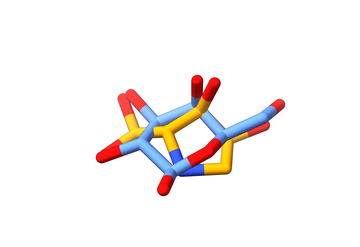In plants, the space between cells is a key battleground during infection. New research shows that to avoid recognition in this space, a strain of the bacterial tomato disease Pseudomonas syringae manipulates plants by producing a substance called glycosyrin. This substance suppresses the immune response and allows the bacteria to remain unnoticed.

An overlay of the structure of glycosyrin (orange) with galactose (blue) when bound to the LacZ protein
The study reveals that glycosyrin does this by mimicking galactose, a simple sugar found in many living things – acting like a wolf in sheep’s clothing.
Glycosyrin represents a novel type of ‘iminosugars’, many of which are used as human drugs to treat metabolic disorders such as type-II diabetes and Fabry disease, because they are stable and mimic sugars – the finding may therefore have medicinal applications. However, glycosyrin has a unique structure amongst this group, and this is what allows it to mimic galactose.
The virulence role of glycosyrin in this strain of P. syringae is dependent on hiding the products of a particular gene. However, there are many strains that hide this gene product in other ways and still produce glycosyrin, indicating that it may serve other roles. The researchers discovered that glycosyrin also alters the biochemistry of the space between cells more broadly, and it is likely that it changes cell wall properties and cell-to-cell communication and connection. Lead researcher Professor Renier van der Hoorn said:
“We discovered the structure of this molecule, its biosynthesis, and its regulation – and then we realised how it mimics galactose and changes the glycobiology of many plants, including crops, in many other ways. We will investigate this further for many years to come.”
Different P. syringae strains infect diverse host plants, including almond, olive, leek, and bean. Similar iminosugar biosynthesis genes are found in these other plant pathogens, so it is likely that glycosyrin is a common strategy used by these bacteria to manipulate host plants.
The study was made possible by an interdisciplinary collaboration across structural biology, bacterial genetics, synthetic chemistry, and metabolomics. Professor van der Hoorn added:
“We used the same LacZ gene that first-year students use in practicals, because its product is also sensitive to glycosyrin. We took advantage of LacZ inhibition to identify the biosynthesis genes and to resolve the structure. This was also a very productive interdisciplinary collaboration with experts: Gail Preston (biology), Peijun Zhang (structural biology), Markus Kaiser (synthetic chemistry) and others.”
To read more about this research, published in Science, visit: https://www.science.org/doi/10.1126/science.adp2433